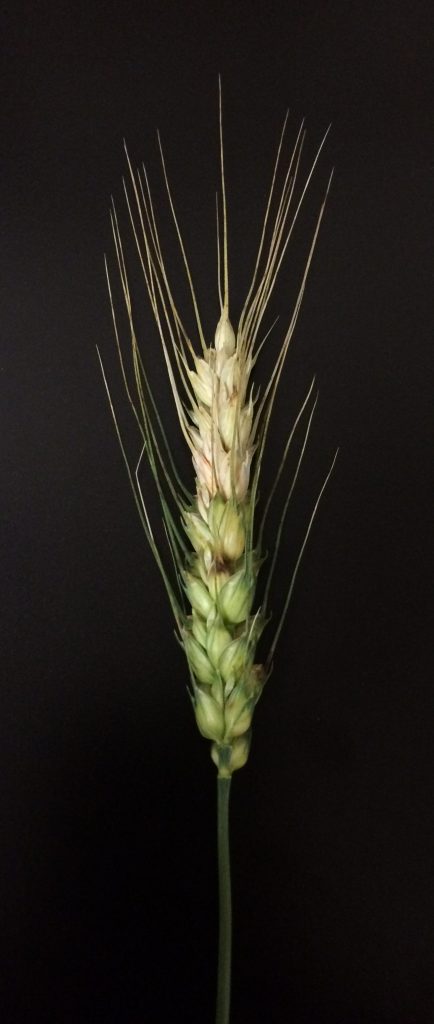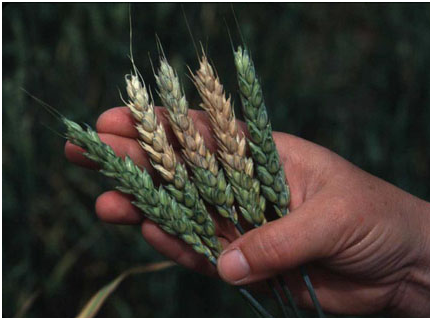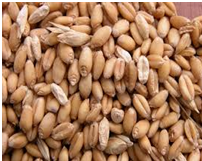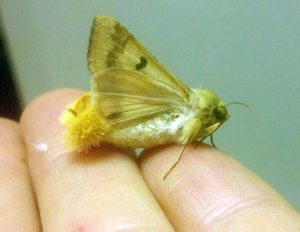Kelly Nichols, Agriculture Agent Associate
University of Maryland Extension, Frederick County
kellyn@umd.edu
With all of the rain that we have had earlier this spring in some areas, nitrogen deficiency is likely to show up, if it hasn’t already. Nitrate (NO3–) is the main form of nitrogen that plants take up. When soils are saturated, the bacteria in the soil do not have access to oxygen in the air, so they use the oxygen in nitrate instead. During this process, called denitrification, nitrate is converted to a gaseous form of nitrogen. The nitrogen gas then is lost to the atmosphere and is no longer available to plants.
The symptoms of nitrogen deficiency will show up on the lowest leaves of the plant first. Nitrogen is mobile in the plant, so if it runs out of nitrogen, it will pull nitrogen from the lower leaves and send it to the newer leaves. The nitrogen-deficient leaves will be yellow; this yellowing will start at the tip of the leaves and move along the middle of the leaf.
If your plants are starting to show nitrogen deficiency, don’t panic! There is still time to correct this by adding additional nitrogen. There are two tools that farmers can use to determine if and how much additional nitrogen should be added.
The first tool is a tissue test. This test can be used for not only nitrogen deficiencies, but also to detect other nutrient deficiencies. A majority of the soil testing labs in the region also offer plant tissue analysis. After choosing which lab you will send your samples to, make sure you find the tissue sampling instructions on the lab’s website. Samples will need to be taken from a specific part of the plant at a specific growth stage of the plant. The lab has calibrated their tests to those plant parts and growth stages; a different method of sampling will result in a useless report.
Take two samples – one from the area that is deficient, and one from an area that is not deficient. Both areas should have similar management practices. Once you have the results, you can compare the two areas and determine practices to mitigate any nutrient deficiencies. If additional fertilizer is needed and you have a nutrient management plan, work with your plan writer to ensure that you are in compliance with applying the additional fertilizer.
The second tool is the Pre-Sidedress Nitrogen Test (PSNT). This test is offered by University of Maryland Extension Nutrient Management Advisors and can be used on corn. The PSNT is a soil test that can be taken when the corn is 6-12 inches tall. This is just prior to when the corn is about to rapidly take up nitrogen. The results of the PSNT will tell if you there is enough nitrogen in the soil to get the corn through its next growth spurt.
The PSNT can be used in fields that have a previous crop of a legume and/or have had manure or biosolids applied. The PSNT cannot be used in fields that have received more than 50 lbs/A of commercial fertilizer nitrogen, or in fields that have a history of receiving commercial fertilizer as the only nutrient source.
Contact your county’s nutrient management advisor if you would like to schedule an appointment for a PSNT. Below are the steps for taking a soil sample in order to prepare for a PSNT. Remember that the soil sample needs to be taken when the corn is 6-12 inches tall.
Soil samples should be taken 12 inches deep (or as deep as you can get them) midway between the rows. Thirty to forty cores should be taken. Put the samples in a bucket, break up any clumps of soil, remove any rocks or other foreign material, and mix the soil. Spread the soil out on newspaper to dry. The samples should be dried immediately after they are taken.
A few soil testing labs around the region also offer the PSNT. If you choose to use one of these labs, check their sampling procedure on when and how to take samples, as it may differ. Also check with your nutrient management plan writer once you have the results to ensure that you are in compliance with your nutrient management plan if you sidedress nitrogen.
One last note – there are a couple of other nutrient deficiencies that have symptoms similar to nitrogen deficiency. Potassium deficiency looks like a yellowing or burning also on the lower leaves. However, it will appear on the edges of the leaves (as opposed to nitrogen which appears in the middle of the leaves). Sulfur deficiency also results in yellow leaves. However, sulfur is not a mobile nutrient in the plant. When the plant runs out of sulfur, the top leaves will become yellow. (Nitrogen deficiency starts in the bottom leaves.)

 Farmers are invited to attend the Maryland Commodity Classic on Thursday, July 26, 2018, at Queen Anne’s County 4-H Park. Hosted by the Maryland Grain Producers Association, Maryland Soybean Board, Maryland Grain Producers Utilization Board, and Mid-Atlantic Soybean Association, the annual meeting is the premier event for grain farmers in the region.
Farmers are invited to attend the Maryland Commodity Classic on Thursday, July 26, 2018, at Queen Anne’s County 4-H Park. Hosted by the Maryland Grain Producers Association, Maryland Soybean Board, Maryland Grain Producers Utilization Board, and Mid-Atlantic Soybean Association, the annual meeting is the premier event for grain farmers in the region.







